How to Do an SEO Competitor Analysis in WordPress
Want to know how your competitors are growing their web traffic and increasing their SEO ranking? You can conduct an SEO Competitive Analysis to find out your competitor’s strategies.
A detailed competitive analysis can help you understand what you need to improve to make your site as good as your competitors. Therefore, this article will explain How to Do an SEO Competitor Analysis in WordPress.
What Is An SEO Competitor Analysis?
SEO competitor analysis is an effective research strategy to help your website rank higher and gain more traffic.
It is a way of detailed analysis of your competitor’s website to know your website’s strengths and weaknesses. It works as a guide in the journey of your digital success.
What is the need to Perform an SEO Competitor Analysis?
Competitive analysis can be your guide that will help you make strategies for improving your site’s ranking and customer experience.
This will let you know what your competitors are doing, how they are above the table, what approach they use to create their content, and what is working for them to attract traffic to their site.
You can also discover the strengths and weaknesses of your competitor’s site and then analyze your site too. This will help you work on the weak points of both and utilize them to improve your ranking.
By studying the success strategies of your competitor’s site, you can boost your site’s performance and grow your WordPress site’s traffic.
How to do an SEO competitor Analysis
Here, we will explain two different SEO tools to perform SEO competitor analysis:
1.Semrush
2.Ahrefs
Method 1: Using Semrush
Semrush is a popular website analyzer and SEO checker tool in the market and is preferred by bloggers and professional SEO experts.
It shows a practical competitor analysis that helps you find keywords they’re using, their top content, backlinks, and much more.
To conduct SEO competitor analysis by Semrush, first of all, sign up to create an account on the semrush website.
After signing up, it will provide many options to analyze your competitor.
1. Domain overview

Click on the Competitive Research and head over the ‘Domain overview’ section on your left menu.
Then, enter your competitor’s URL and click on the ‘Search’ button. After that, Semrush will give you an overview of your competitor’s website.
Here, You can see its authority score, paid search traffic, backlinks, organic search traffic for the current month, and display advertising.
It also displays which country put up the most traffic share and a monthly organic traffic graph.

Additionally, you can inspect other reports such as organic keywords, main organic competitors, and organic position distribution in the Domain overview.
The Domain overview reports quickly display how your competitor is performing. You can analyze the data, set plans for your website, and find areas of improvement.
2. Traffic Analytics
Now, go to the ‘Traffic Analytics’ section for more detailed analysis from the menu on your left. Semrush gives you a clear structure of your competitor’s traffic sources in this section.
You can view the total visits, average visit duration, unique visitors, and bounce rate.
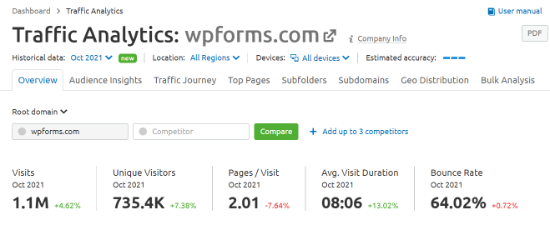
You can scroll down to see the top traffic sources and see which source attracts many visitors.
For example, Suppose the competitor site is getting more users from social media, and you are not getting half of it. Then you must find a way to attract and grow more traffic from social media platforms.
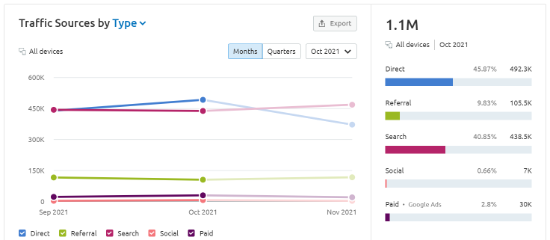
3. Organic Research
After that, you can move to the ‘Organic Research’ section from the left menu.
In this option, you can uncover your competitor’s top keywords, top pages, position changes, search engine page results (SERP) features such as featured snippets, and more.
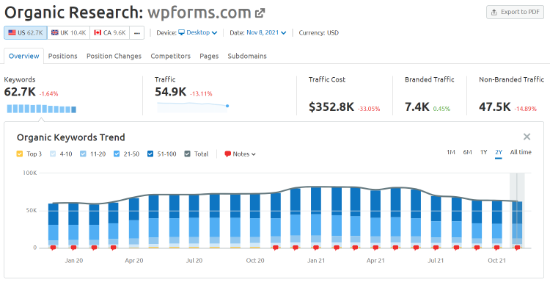
To start organic research, you can see the Top Organic Keywords to find out which search terms users use to find your competitor’s website.
Semrush also displays the search term position, search intent volume, and more.
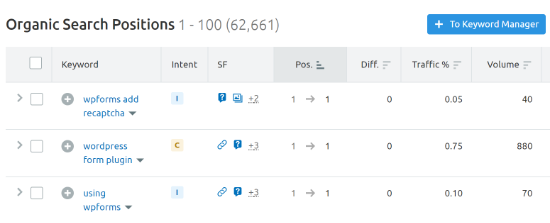
It also helps identify opportunities to capture SERP features and find new keywords to target on your website.
For example, you can view the pages that push the most organic traffic to your competitor. When you identify the pages, you can cover similar topics on your site.
4. Keyword Gap
Next, go to the Keyword Gap section from the menu on your left and get more understanding of your competitors’ search terms.
Semrush offers a keyword gap tool and lets you enter five domains. You can enter your website, your competitor’s websites, select the Organic keywords option, and click the ‘Compare’ button.

After that, Semrush displays the list of keywords shared between you and your competitors.
From here, you can look at the ‘Missing’ keywords report.
The missing keyword report displays the search terms you have not used on your website but used by your competitor. This helps you find new keywords to work on to grow your web traffic.

5. Backlinks
Moving ahead, You can use Semrush to identify backlinks. These are the important Google ranking factor, and they also provide a vote of confidence for your site.
As backlinks impact a site’s SEO in a positive manner, it is necessary to find out the spot where your competitors are getting their backlinks. Then you can use this data to get backlinks for your site.
Head over to the ‘Backlink Gap’ section for backlinks, enter up to five competitor websites and then click the ‘Find prospects’ button.
Semrush will display a list of referring domains linking to your competitors.

Choose a competitor from the ‘Prospects for domain’ menu, then filter the selected domains as best, strong, weak, unique, and shared.
Now go ahead and select the ‘best’ option to find backlinks that only indicate to your competitor and not for you.
With this method, you’ll find new possibilities to get more backlinks for your site and raise your keyword rankings.
6. Backlink Analytics
Semrush provides another way to find backlinks from your competitor’s site by looking for lost links.
For this, visit the ‘Backlink Analytics’ section from the left menu.
Now, enter your competitor’s website URL and click the ‘Analyze’ button.
Next, head over to the ‘Backlinks’ tab and select ‘Lost’ from the available filters.
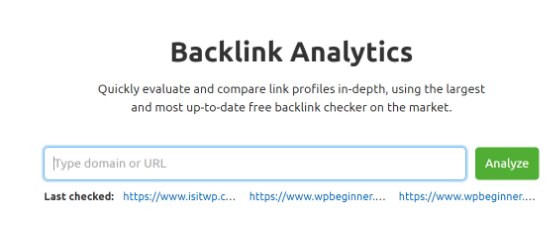
Semrush will show all the backlinks of your competitor that do not exist.
You to gain more backlinks this way. You can list your blog post or landing page to replace the lost backlink to referring site.

Method 2: Using Ahrefs
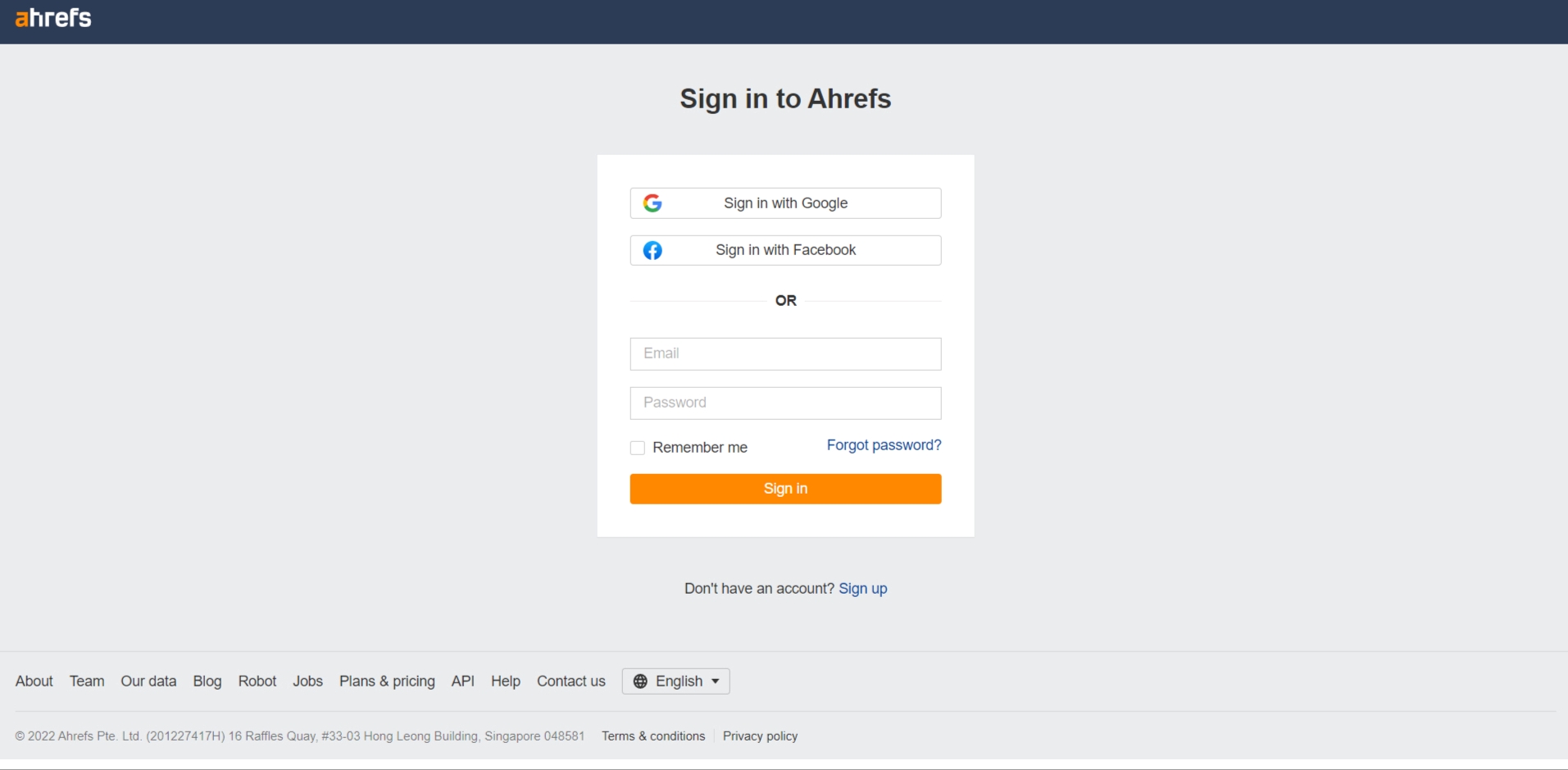
Ahrefs is an All-in-one SEO toolset that provides site audits to optimize your website. It is a site explorer that helps analyze your competitors, a keywords explorer to study what your customers are searching for, A content explorer to find out top-performing content, and A rank tracker to track your ranking progress.
To start competitor analysis using Aherfs, First of all, visit the aherfs site. It offers a free trial, or you have to create an account to sign up.
After signing up, it will provide different options to analyze your competitor’s site.
Following are some of them.
1. Organic Research for Competitive keyword analysis
The Competitors with high-ranking keywords raise the threat to your website traffic.
Ahrefs Site Explorer tool for Organic Research estimates the number of organic keywords a website ranks for and relates the keywords’ positions. It gives you the idea of how your competitor is showing up in the search results.

For instance, A company that sells cloud solutions wants to know what their competitor, IBM, is doing.
We can see this in Ahrefs’s Site Explorer by dropping their cloud services page URL and can find the keywords they are ranking for and the keyword ranking positions. We can also find the organic traffic and keywords over time in the Organic Search section.
2. Competitive Backlinks analysis
As we mentioned above, Backlinks are one of the most important factors considered by Google when it ranks content in search engine results. Therefore you should analyze your competitors’ backlinks.
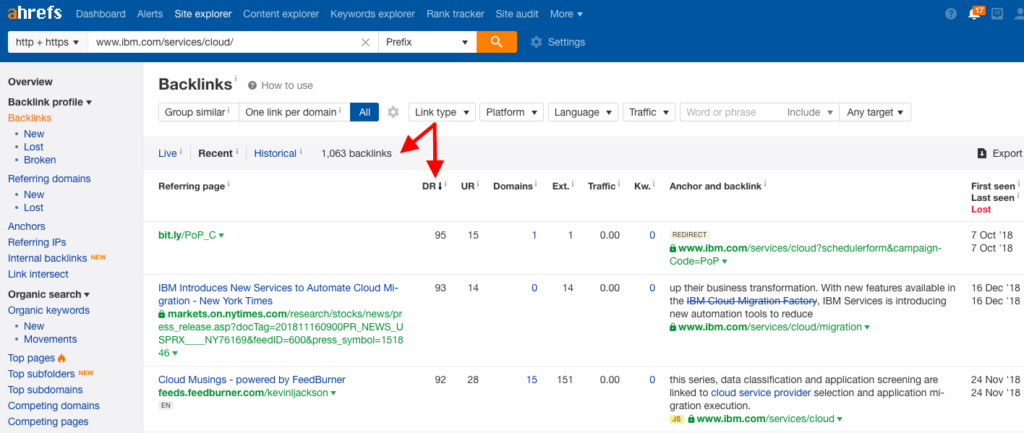
You can use Ahrefs’ Site Explorer for Backlinks Analysis.
This will help you make strategies for building your links and what websites you should target as part of that strategy.
Moreover, The Link Intersect tool by aherfs helps to know which websites specifically link to your competitors, but not you.
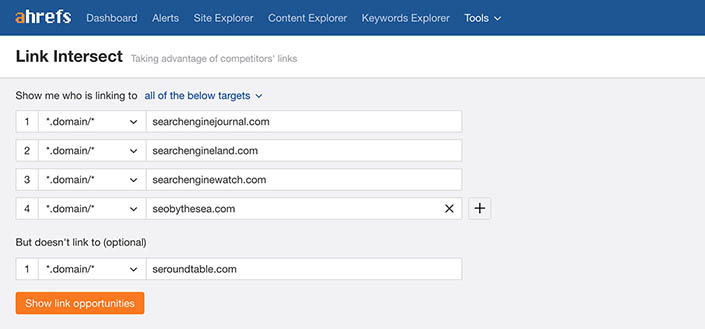
3. Competitive content analysis
Now you have got the idea by analyzing the data of your competitor’s website. Then you have to look for the type of content they are writing.
Are they including graphics or video in their content? Are they targetting multiple stages? By manually reviewing your competitors’ websites, you can figure out how to improve your content or your marketing strategies.
For this, you can use Ahrefs’ Site Explorer Top Pages section. You can see competitors’ top pages by estimating organic traffic and the highest-performing pages.
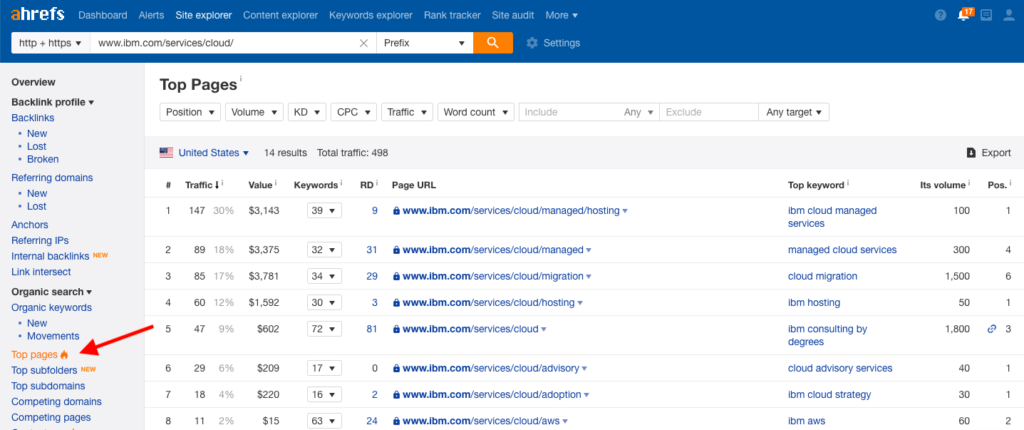
To conclude-
SEO competitor analysis is an effective research strategy to help your website rank higher and gain more traffic. It’s not only about your competitors but also your visibility and how you can improve it.
This section covers Semrush and Ahrefs the two different tools to conduct an SEO Competitive Analysis. After analyzing, you could find a new content strategy, backlinks, and on-page improvements.
